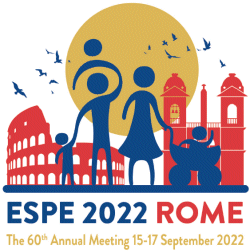
60th Annual ESPE (ESPE 2022)
Rome,
Italy
15 Sep 2022 - 17 Sep 2022
Poster Category 2
Fetal, Neonatal Endocrinology and Metabolism
hrp0095p2-128 | Fetal, Neonatal Endocrinology and Metabolism | ESPE2022
Placental Weight and their relation to Infant Birth weight and Gender, Gestational Age, and Maternal Age: (A Population-Based Retrospective Data Analysis (n = 80722)
Alyafei Fawzia , Mai Al-qubasi , Soliman Ashraf , Ali Hamdy , Olukade Tawa , Alturk Mohamed , Alaaraj Nada , Hamed Noor , Ahmed Shayma
hrp0095p2-129 | Fetal, Neonatal Endocrinology and Metabolism | ESPE2022
Molecular pathways linking fetal growth restriction to cardiometabolic risk in childhood
Perchard Reena , Higgins Lucy , Garner Terence , Stevens Adam , Johnstone Edward , Clayton Peter
hrp0095p2-130 | Fetal, Neonatal Endocrinology and Metabolism | ESPE2022
Postnatal Growth in Infants of Diabetic Mothers (IDM) (n = 79) Who Were Born at or Near Term and Had Severe Neonatal Hypoglycemia Without Other Comorbidities.
Alaaraj Nada , Soliman Ashraf , Ahmed Shayma , Hamed Noor , Alyafei Fawzia , Ali Hamdy , Itani Maya , Al-Naimi Fatima , Shaat Mona , Al-Yousef Doaa
hrp0095p2-131 | Fetal, Neonatal Endocrinology and Metabolism | ESPE2022
Small for Gestational Age (SGA) Babies Identified Through in the Pilot Programme for Early Detection and Follow-Up of SGA Children
Zlateva Tanya , Tsochev Kaloyan , Krumova Darina , Pramatarova-Kamburova Tanya , Krasteva-Vilmosh Maya , Georgieva Ralitsa , Iotova Violeta
hrp0095p2-132 | Fetal, Neonatal Endocrinology and Metabolism | ESPE2022
Hyperinsulinaemic Hypoglycaemia – are neonates symptomatic during hypoglycaemia?
Cousins Ruth , Athanasakopoulou Sapfo , Urs Mithuna , Shah Pratik
hrp0095p2-133 | Fetal, Neonatal Endocrinology and Metabolism | ESPE2022
Hypoglycemia as a result of growth hormone deficiency and Glycogen storage disease type 0a in a patient with short stature – case report
Okońska Maja , Myśliwiec Małgorzata
hrp0095p2-134 | Fetal, Neonatal Endocrinology and Metabolism | ESPE2022
Neonatal hypoglycemia in infants of diabetic mothers vs infants of non-diabetic mothers in relation to birth weight
Soliman Ashraf , Ali Hamdy , Mahmoud Nazla
hrp0095p2-135 | Fetal, Neonatal Endocrinology and Metabolism | ESPE2022
Incidence of neonatal hypoglycemia in Qatar: A 3-year study
hrp0095p2-136 | Fetal, Neonatal Endocrinology and Metabolism | ESPE2022
Growth patterns in Infants with Significant Neonatal Hypoglycemia during the first two years of age: Comparison of infants of Diabetic Mothers (IDM) vs infants of non-diabetic mothers (INDM)
Alaaraj Nada , Soliman Ashraf , Ahmed Shayma , Hamed Noor , Alyafei Fawzia , Ali Hamdy , Itani Maya , Al-Naimi Fatima , Shaat Mona , Al-Yousef Doaa
hrp0095p2-137 | Fetal, Neonatal Endocrinology and Metabolism | ESPE2022
Relationship Between Birth Body Weight≪10.Th Centile (Sga) And Insulin-Like Growth Factor Binding Protein-2 / Insulin-Like Growth Factor Binding Protein-3 Ratio In The Not-Life Threatened Newborn: Relevance Of Birth Chest Circumference / Birth Body Weight Ratio
Terzi Cesare , Virdis Raffaele , Magnani Cristiana , Tridenti Gabriele , Cerioli Andrea , Riani Marco , Garavelli Lidia , Bernasconi Sergio , Luigi De Angelis Gian , F. Blum Werner , Banchini Giacomo
hrp0095p2-138 | Fetal, Neonatal Endocrinology and Metabolism | ESPE2022
Hypoglycemia in children: Clinical experience of a tertiary care center
Gil Margolis Merav , Lilos Pearl , Phillip Moshe , de Vries Liat
hrp0095p2-139 | Fetal, Neonatal Endocrinology and Metabolism | ESPE2022
A stormy neonatal course
Brown Katie , Kaninde Abhidhamma , Law James , Nadar Ruchi , Saraff Vrinda , Mohamed Zainaba
hrp0095p2-140 | Fetal, Neonatal Endocrinology and Metabolism | ESPE2022
POU1F1 gene mutation as a cause of central hypothyroidism and growth hormone deficiency: a case report
Sawicka Beata , Borysewicz-Sańczyk Hanna , Sztatyłowicz Aleksandra , Michalak Justyna , Stożek Karolina , Bossowski Artur
hrp0095p2-141 | Fetal, Neonatal Endocrinology and Metabolism | ESPE2022
Relationship Between Birth Body Weight<10.TH Centile (SGA) and Insulin-Like Growth Factor-I in The Not-Life Threatened Newborn: Relevance of Birth Chest Circumference / Birth Body Weight Ratio
Terzi Cesare , F. Blum Werner , Magnani Cristiana , Tridenti Gabriele , Cerioli Andrea , Riani Marco , Bernasconi Sergio , Chesi Elena , Luigi De Angelis Gian , Virdis Raffaele , Banchini Giacomo
hrp0095p2-142 | Fetal, Neonatal Endocrinology and Metabolism | ESPE2022
Case Report of an Infant with Severe Symptomatic Hypoglycemia and A Rare ABCC8 Gene Mutation Inherited from his Unaffected Father and A Focal form of Hi
Tumasyan Dalar , Markosyan Renata
hrp0095p2-143 | Fetal, Neonatal Endocrinology and Metabolism | ESPE2022



